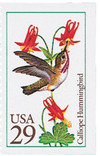
# 2646 - 1992 29c Hummingbirds: Calliope
US #2646
1992 Calliope Hummingbird
- From a booklet pane picturing five species of hummingbirds found in the US
- Original painting used for image created by Chuck Ripper, who had painted many other US bird stamps
Category of Stamp: Commemorative
Set: Hummingbirds
Value: 29¢, First-class Mail Rate
First Day of Issue: June 15, 1992
First Day City: Washington, DC
Quantity Issued: 87,728,000
Printed by: American Bank Note Company
Printing Method/Format: Photogravure
Perforations: 11
Reason the stamp was issued: Birds are a favorite topical stamp subject, and people are fascinated by hummingbirds.
About the stamp design: The artwork for the Ruby-throated hummingbird stamp was done by Chuck Ripper. He is the talent behind many stamps featuring birds and nature in past, including a Broad-tailed hummingbird on the American Wildlife pane of 50.
The artist picked five species of hummingbirds that “covered the most ground geographically and also offered color variety.” Each stamp shows a hummingbird in flight with a red flower, which is found in its range.
First Day City: The First Day of Issue ceremony was held during the National Audubon Society’s convention held at American University in Washington, DC.
More fun facts Calliope Hummingbird: This is the smallest bird in North America, with a length of less than four inches. Its coloring is metallic green on its back and white below. The male also has metallic purple feathers under it chin. The calliope can be found in the mountains of the Western US, at elevations up to 11,500 feet.
Hummingbirds are found only in Western Hemisphere. John James Audubon called them “glittering fragments of the rainbow” because of their iridescent colors. They are the smallest family of birds and have the fastest metabolism. They can hover, fly backwards, up, and down. The name is from sound of rapidly beating wings. Hummingbirds have pointed beaks that are ideal for fitting inside flowers to get to the nectar and insects.
US #2646
1992 Calliope Hummingbird
- From a booklet pane picturing five species of hummingbirds found in the US
- Original painting used for image created by Chuck Ripper, who had painted many other US bird stamps
Category of Stamp: Commemorative
Set: Hummingbirds
Value: 29¢, First-class Mail Rate
First Day of Issue: June 15, 1992
First Day City: Washington, DC
Quantity Issued: 87,728,000
Printed by: American Bank Note Company
Printing Method/Format: Photogravure
Perforations: 11
Reason the stamp was issued: Birds are a favorite topical stamp subject, and people are fascinated by hummingbirds.
About the stamp design: The artwork for the Ruby-throated hummingbird stamp was done by Chuck Ripper. He is the talent behind many stamps featuring birds and nature in past, including a Broad-tailed hummingbird on the American Wildlife pane of 50.
The artist picked five species of hummingbirds that “covered the most ground geographically and also offered color variety.” Each stamp shows a hummingbird in flight with a red flower, which is found in its range.
First Day City: The First Day of Issue ceremony was held during the National Audubon Society’s convention held at American University in Washington, DC.
More fun facts Calliope Hummingbird: This is the smallest bird in North America, with a length of less than four inches. Its coloring is metallic green on its back and white below. The male also has metallic purple feathers under it chin. The calliope can be found in the mountains of the Western US, at elevations up to 11,500 feet.
Hummingbirds are found only in Western Hemisphere. John James Audubon called them “glittering fragments of the rainbow” because of their iridescent colors. They are the smallest family of birds and have the fastest metabolism. They can hover, fly backwards, up, and down. The name is from sound of rapidly beating wings. Hummingbirds have pointed beaks that are ideal for fitting inside flowers to get to the nectar and insects.












